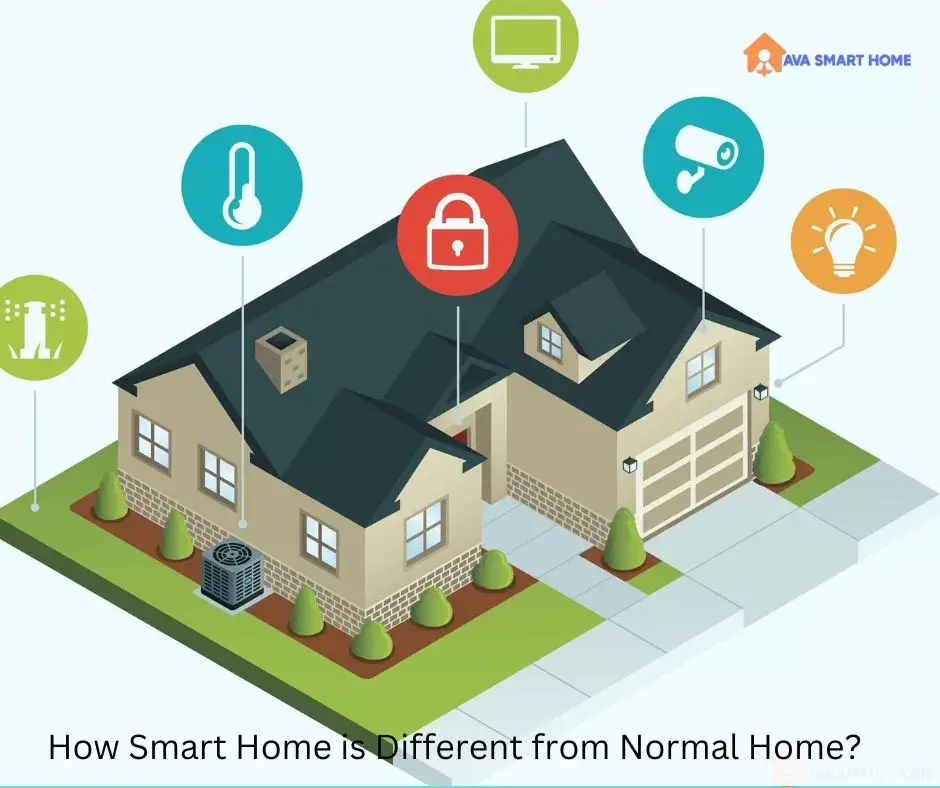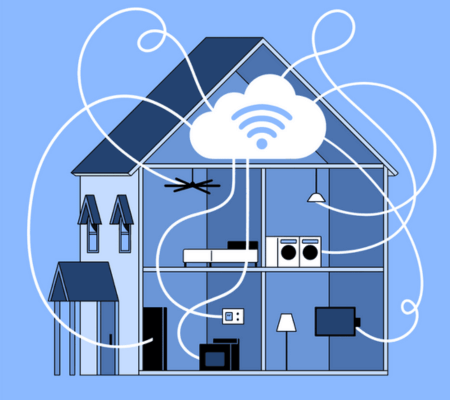Welcome to the future of home living! Imagine a world where your house anticipates your every need, adapts to your preferences, and keeps you connected even when you’re miles away. This is the power of a smart home – an innovative technological marvel revolutionizing how we live.
Gone are the days of manually adjusting thermostats or worrying about leaving appliances on. With a smart home, convenience and efficiency take center stage, making everyday tasks simpler and more streamlined. But what exactly is a smart home? How does it work? And what advantages does it offer?
We will explore the concept of smart homes in detail and uncover their numerous benefits. From enhanced safety to energy management and everything in between, discover why converting your humble abode into a haven could be one of the best decisions you’ll ever make. So, let’s dive right in and unlock all that awaits within smart homes!
Table of Contents
ToggleWhat is a Smart Home?
What exactly is a smart home, you ask? Well, think of it as your assistant that operates within the walls of your house. It’s a network of interconnected devices and systems that work seamlessly to automate and optimize your daily life.
At its core, a smart home utilizes advanced technology – such as sensors, cameras, and Internet connectivity – to gather information about your surroundings and adjust accordingly. These intelligent devices can communicate with each other through wireless networks or even the power lines in your home.
From controlling lighting and temperature settings to managing security systems and household appliances, the possibilities are virtually endless regarding what a smart home can do. Imagine being able to effortlessly dim the lights or adjust the thermostat with just a voice command or tap on your smartphone. Or how about receiving real-time alerts if an intruder is detected or a water leak is in progress?
A smart home puts you back in control by providing convenience at every turn. With just the touch of a button (or even without lifting a finger), you can access enhanced functionality that simplifies tasks and improves efficiency throughout your living space.
So whether it’s optimizing energy usage for cost savings or ensuring maximum safety through automated surveillance systems, having a smart home means living in an environment where technology enhances every aspect of daily life. It’s like stepping into tomorrow today!
How Smart Homes Work
Smart homes have revolutionized how we live, offering a level of convenience and control that was once unimaginable. But how exactly do these futuristic houses work? Let’s delve into the inner workings of smart home technology.
At the heart of a smart home is a central hub or controller that acts as the brain, connecting all the devices and systems within your home. This hub communicates with various sensors, appliances, and other smart devices through Wi-Fi or Bluetooth.
These interconnected devices can be controlled remotely from a smartphone or tablet using dedicated apps or voice commands through virtual assistants like Amazon Alexa or Google Assistant. This means you can turn on lights, adjust thermostats, lock doors, and even start your coffee maker before you get out of bed – all with just a few taps on your phone.
To enable this seamless communication between devices, smart homes rely on protocols like Zigbee or Z-Wave to establish secure networks. These protocols ensure that different brands and types of devices can communicate effectively with each other without any compatibility issues.
In addition to remote control capabilities, smart homes also feature automation features. With programmable routines and schedules, you can automate tasks such as turning off lights when no one is in the room or adjusting temperature settings based on occupancy patterns.
Moreover, many smart home systems incorporate machine learning algorithms to adapt to your preferences over time. For example, if you consistently lower the thermostat at night before sleeping, the system may learn this pattern and automatically adjust it for you in future nights.
Understanding how smart homes work helps us appreciate their potential benefits better. By interconnecting our devices and automating everyday tasks, they offer us unparalleled convenience, comfort, efficiency, and security. Whether it’s controlling our environment remotely, monitoring safety measures in real-time, or optimizing energy usage – there’s no denying that smart homes are changing our lives for good! So why not embrace this technological marvel today and experience the advantages of a smart home for yourself?
Benefits of Smart Home Technology
Easy Interconnectivity:
One of the key benefits of smart home technology is its ability to seamlessly connect various devices and systems within your home. With a central hub or app, you can control everything from lighting and temperature to security cameras and appliances. This interconnectivity allows for greater convenience and efficiency in managing your home.
Remote Monitoring & Check-Ins:
Smart homes enable remote monitoring, allowing you to keep tabs on your property even when you’re away. Whether it’s checking if you locked the front door or viewing live video feeds from security cameras, this feature provides peace of mind and enhances security measures.
Customized Preferences & Settings:
Another advantage is the ability to customize preferences and settings based on individual needs. With smart home technology, you can create personalized profiles that adjust lighting, temperature, music playlists, and more according to individual preferences.
Increased Safety & Real-Time Monitoring:
Smart homes provide real-time monitoring capabilities for enhanced safety. You can receive instant alerts regarding any suspicious activity, such as break-ins or smoke detection. Additionally, features like smart locks allow for secure access control.
Health & Wellness Tracking:
Some smart home devices offer health tracking features that monitor air quality levels or sleep patterns. This information helps users make informed decisions about their well-being while creating a healthier living environment.
Energy & Utilities Management:
Smart homes promote energy efficiency by allowing users to manage their utilities effectively. Features such as automated thermostats help optimize energy consumption by adjusting temperatures based on occupancy patterns.
Video Motion Detection:
Video motion detection is an essential feature that enables homeowners to identify any movement captured by surveillance cameras in specific areas of their property. It adds an extra layer of security by alerting homeowners immediately when unexpected motion is detected.
Video Analytics Technologies:
Advanced video analytics technologies integrated into smart home systems provide valuable insights into activities inside and outside the house. These technologies include facial recognition software or object recognition, enhancing security and surveillance capabilities.
Appliance Safety & Automatic Shutoffs
Easy Interconnectivity
Easy interconnectivity is one of the key advantages of using a smart home. This technology lets all your devices and appliances be connected and controlled from a central hub or even through your smartphone. This means you can control your home’s lighting, heating, security systems, entertainment systems, and more.
Imagine turning off all the lights in your house with just a tap on your phone before bed. Or adjusting the temperature in different rooms without getting up from the couch. Easy interconnectivity allows for seamless integration between various devices and systems within your home.
Not only does easy interconnectivity provide convenience, but it also offers greater efficiency. You can set up automation routines so that certain actions happen automatically based on triggers or schedules. For example, you could program your blinds to open at sunrise or have your coffee maker start brewing as soon as you wake up.
Another benefit of easy interconnectivity is monitoring and controlling everything remotely while away from home. Forgot to lock the door? No problem – access an app on your phone and secure it remotely.
Furthermore, easy interconnectivity enables cross-device communication. For instance, if someone rings your doorbell while watching TV in another room, you can receive an alert on both your smartphone and smart TV simultaneously.
Easy interconnectivity brings convenience, efficiency, remote monitoring capabilities, and enhanced communication between devices within a smart home setup. Embracing this technology allows homeowners to streamline their daily tasks while enjoying increased comfort and control over their living spaces.
Remote Monitoring & Check-Ins
One of the greatest advantages of having a smart home is the ability to remotely monitor and check in on your house, no matter where you are. With just a few taps on your smartphone or tablet, you can access live video feeds from security cameras placed around your property.
This feature provides peace of mind for homeowners who frequently travel or have second homes. Whether at work, on vacation, or running errands, you can quickly and easily see what’s happening at home in real time. This allows you to watch children, pets, or even potential intruders.
In addition to video monitoring, smart home technology enables remote access to other devices and systems within your home. For example, you can adjust the thermostat temperature before returning from a trip to be comfortable upon arrival. You can also turn lights on and off remotely to give the appearance that someone is home.
Remote monitoring and check-ins provide convenience and security by allowing homeowners to stay connected with their homes regardless of location. It adds an extra layer of control and ensures everything is in order when they are away.
Customized Preferences & Settings
Customized Preferences & Settings in a smart home bring homeowners a new level of convenience and comfort. With smart technology, you can tailor your living space to suit your unique needs and preferences.
Imagine waking up to your favorite playlist softly playing in the background as the lights gradually brighten to simulate a sunrise. With smart home automation, you can create personalized scenes that set the perfect ambiance for any occasion – whether it’s movie night or hosting a dinner party.
Not only can you control lighting and music, but also temperature settings. Set different temperatures for different zones within your home, or adjust them remotely using a smartphone app. This means no more returning to an uncomfortably hot or cold house after work!
Smart homes also allow individual customization for each family member. Personal profiles can be created with specific preferences for lighting, temperature, music choices, and even preferred TV channels.
Voice assistants like Amazon Alexa or Google Assistant make it easy to control various aspects of your smart home through simple voice commands. Just imagine being able to effortlessly adjust settings without lifting a finger!
In short, customized preferences and settings take personalization in our living spaces to new heights by allowing us full control over every aspect of our home’s environment. It brings convenience, comfort, and an unparalleled sense of ownership over one’s surroundings!
Investing in a smart home system with increased safety and real-time monitoring capabilities can protect your loved ones and valuable possessions, no matter where you are.
Health & Wellness Tracking
One of the key advantages of using a smart home is the ability to track and monitor your health and wellness. With advanced sensors and wearable devices, you can easily keep tabs on important aspects of your well-being from the comfort of your home.
Smart homes with health tracking capabilities allow you to effortlessly monitor vital signs such as heart rate, blood pressure, and sleep patterns. This data can provide valuable insights into your overall health, allowing you to make informed lifestyle choices or seek medical attention if necessary.
Utilizing a smart home for health monitoring provides convenience, accessibility, and peace of mind when managing one’s well-being. With real-time data at your fingertips, you have greater control over maintaining a healthy lifestyle without constant visits to healthcare professionals.
Energy & Utilities Management
Smart home technology offers numerous advantages regarding energy and utility management. By integrating smart devices into your home, you can gain more control over your energy usage, reduce waste, and save money on utility bills.
One of the key benefits is the ability to monitor and manage your energy consumption remotely. With smart meters and connected devices, you can easily track how much electricity or water you use in real time. This allows you to make adjustments as needed and identify areas where you can be more efficient.
Smart thermostats are another valuable tool for managing energy usage. These intelligent devices learn your preferences and automatically adjust the temperature based on occupancy patterns or time of day. You can also control them remotely through a smartphone app, meaning no more wasted heating or cooling while nobody is home.
Smart lighting systems offer similar benefits by allowing you to schedule lights to turn on or off at specific times or dimming them when natural light is sufficient. This not only saves energy but also enhances convenience and security.
Furthermore, many smart appliances now have features that optimize their performance for maximum efficiency. For example, some washing machines have sensors that determine load size and adjust water levels accordingly, reducing water consumption and utility costs.
Incorporating smart home technology into your energy management strategy gives homeowners greater visibility into their consumption habits while offering practical solutions for reducing waste without sacrificing comfort or convenience.
Furthermore, Video Motion Detection helps optimize energy usage by automating lighting and heating systems based on occupancy patterns. When no motion is detected in a room for a specified period, lights automatically turn off, and thermostats adjust accordingly, leading to energy savings.
Video Motion Detection is crucial in making smart homes smarter and more secure. It gives homeowners increased control over their property’s safety while adding convenience and efficiency to everyday life.
Video Analytics Technologies
The Future of Smart Home Security
In the ever-evolving world of smart home technology, video analytics technologies are emerging as a game-changer when it comes to ensuring the safety and security of your living space. These advanced systems utilize cutting-edge algorithms and artificial intelligence to analyze real-time video footage captured by security cameras.
One key advantage of video analytics technologies is their ability to detect and identify potential threats or suspicious activities automatically. These systems can differentiate between normal occurrences and potentially dangerous situations by leveraging features such as facial recognition, object detection, and even behavioral analysis.
Another benefit is receiving instant alerts when any unusual activity is detected on your smartphone or other connected devices. Whether it’s an unauthorized entry, a package delivery, or even just someone loitering around your property, you’ll be immediately notified so that appropriate action can be taken.
Furthermore, video analytics technologies offer intelligent search capabilities that allow you to quickly locate specific events within hours upon hours of recorded footage. This saves valuable time compared to manually scrolling through endless recordings searching for a particular incident.
With these powerful tools at your disposal, you can have peace of mind knowing that your smart home security system captures high-quality video and actively analyzes it for potential threats. Video analytics technologies are undoubtedly shaping the future of smart home security by providing enhanced surveillance and proactive monitoring capabilities like never before. So why wait? Embrace this innovative technology today for added protection and convenience for your smart home ecosystem!
Appliance Safety & Automatic Shutoffs
When it comes to the safety of your home, smart technology has got you covered. With appliance safety and automatic shutoffs, you can have peace of mind knowing that potential hazards are being actively monitored and controlled.
You’re rushing out the door in the morning and suddenly realize you forgot to turn off the stove. In a traditional home, this could lead to a dangerous situation. But with a smart home system in place, appliances like stoves, ovens, and even irons can be equipped with automatic shutoff capabilities.
These smart devices are designed to detect abnormal behavior or unsafe conditions, such as excessive heat or prolonged usage. Once detected, they will automatically shut off the power supply to prevent any accidents or damage.
But it doesn’t stop there – smart homes take appliance safety a step further by providing real-time notifications directly to your smartphone if anything goes wrong. This means that even when you’re away from home, you can stay informed about potential risks and take immediate action.
In addition to enhancing safety measures, these automatic shutoff systems also offer energy-saving benefits. You can reduce unnecessary energy consumption and lower your utility bills by ensuring appliances are turned off when not in use or during certain hours of the day.
Incorporating appliance safety features into your smart home setup is an excellent investment for convenience and security. So say goodbye to worries about leaving appliances unattended – let technology work for you!
Read more: How to Protect Your Home Without a Security System?










